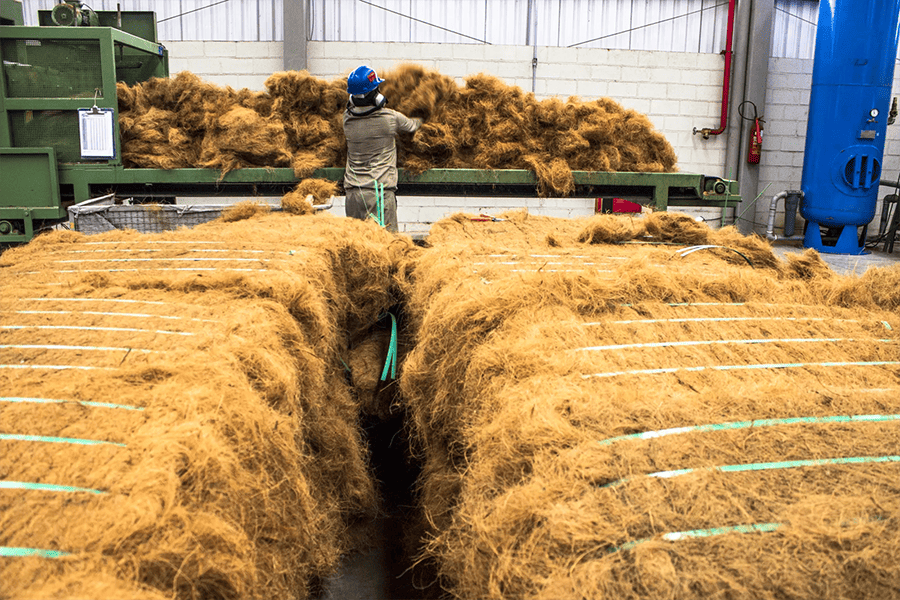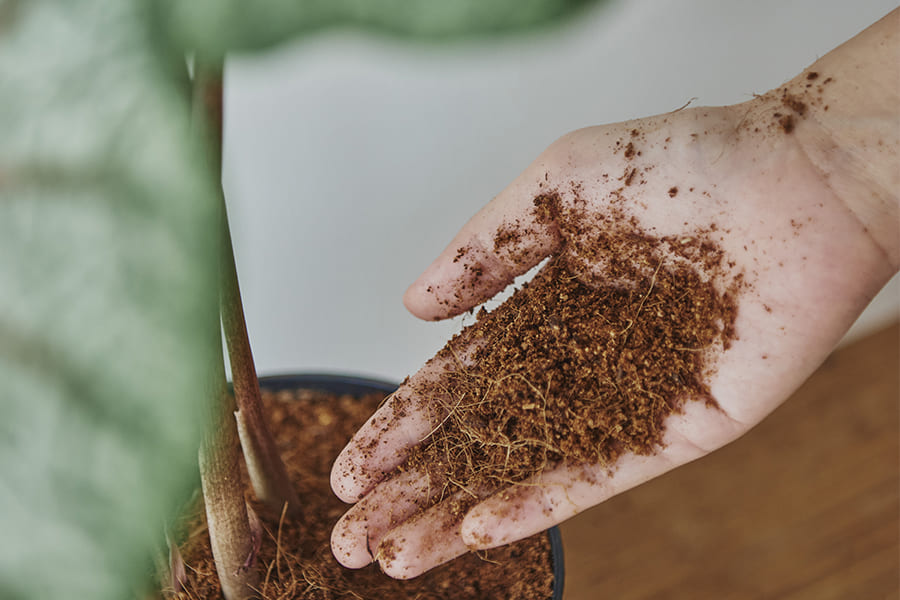BLOG POSTS & ARTICLES
Tips to Grow Juicy Tomatoes with Coco Coir

When it comes to tomato cultivation, using the right growing medium can make all the difference. Coco coir, derived from coconut husks, offers numerous benefits for your tomato plants. It retains moisture exceptionally well, provides excellent aeration for roots, and is a renewable, earth-friendly option. By choosing coco coir, you're not only enhancing the quality of your tomatoes but also contributing to a greener planet.
In this comprehensive blog, we'll take you on a journey to discover the secrets of growing juicy tomatoes with coco coir.
Coco Coir and Its Benefits for Plant Growth
Excellent Water Retention: Coco coir boasts exceptional water-holding capacity, allowing it to retain moisture and keep plants consistently hydrated. This ensures that your tomato plants receive a steady supply of water, promoting healthy growth.
Aeration: Coir's unique texture also provides excellent aeration, preventing root rot and improving overall root health. Tomato plants thrive in well-aerated soil or growing media.
pH Neutral: Unlike other substrates, coco coir is naturally pH neutral, making it an ideal choice for growing a wide range of plants, including tomatoes. It allows you to have precise control over the pH levels in your garden.
Chemical-Free: High-quality coir products, like those offered by Plantbest, are typically free from harmful chemicals or additives, ensuring a safe and natural growing environment for your plants.
Preparing Your Tomato Garden
Selecting the Right Location:
Sunlight: Tomatoes need at least 6-8 hours of direct sunlight daily. Select a spot with ample sun exposure.
Protection from Wind: Protect your plants from strong winds, as they can damage the delicate tomato branches and affect growth. Planting near a windbreak or using garden structures can be helpful.
Choosing the Tomato Varieties
Determinate vs. Indeterminate: Determine if you want determinate (bush) or indeterminate (vining) tomatoes. Determinate types are suitable for compact spaces, while indeterminate varieties yield tomatoes throughout the season.
Heat-Tolerant vs. Cold-Tolerant: Choose varieties that are well-suited to your climate. Heat-tolerant types are ideal for hot summers, while cold-tolerant varieties can withstand cooler temperatures.
Short-Season vs. Long-Season: If you have a shorter growing season, opt for short-season tomato varieties that mature faster.
Planting Tomatoes
Select Your Growing Container: Choose a container or pot suitable for tomatoes. Coco coir can be used in traditional pots or specialized coco coir pots.
Prepare the Coco Coir: If using a brick or block of coco coir, rehydrate it by soaking it in water until it expands. This typically takes about 15 minutes.
Plant Your Tomato Seedlings or Seeds:
-
If transplanting seedlings, create a hole in the coco coir medium and carefully place the seedlings.
-
When planting seeds, sow them at the recommended depth according to the seed packet instructions.
Maintain Adequate Moisture: Coco coir retains water well, but it's important to keep the medium consistently moist, especially during the early growth stages of your tomatoes.
Monitor Nutrient Levels: Coco coir is a neutral medium, so you'll need to provide the necessary nutrients through regular fertilization. Check the pH and adjust if needed.
Benefits of Using Coco Coir Pots for Starting Tomato Plants
Coco coir pots offer several advantages for starting tomato plants:
Biodegradable and Sustainable: Coco coir pots are eco-friendly and can be planted directly into the ground, reducing transplant shock and minimizing waste.
Improved Root Growth: The porous nature of coco coir pots allows roots to grow through the walls, preventing root circling and encouraging healthier root systems.
Excellent Moisture Retention: Coco coir pots retain moisture, reducing the risk of over- or under-watering and promoting consistent hydration for your tomato plants.
Reduced Transplant Stress: When it's time to transplant, you can place the entire coco coir pot into the soil, minimizing disturbance to the roots.
Watering and Nutrient Management
Watering Best Practices:
When growing tomatoes in coco coir, it's crucial to strike the right balance when it comes to watering. Coco coir has excellent moisture-retention properties but should not be waterlogged. Follow these best practices:
Consistency: Maintain a regular watering schedule to ensure the coir remains consistently moist.
Allow for Drainage: Use containers with drainage holes to prevent water accumulation.
Bottom-Up Watering: Water from the bottom of the container to avoid saturating the surface.
Nutrient Management
Coco coir is an inert medium with no inherent nutrients. It's vital to monitor and supplement the nutrient levels for healthy tomato growth. Here's how to do it:
pH Levels: Regularly check and adjust the pH of your coir to be within the optimal range (around 5.8 to 6.3) for nutrient uptake.
Nutrient Solution: Use a balanced, water-soluble fertilizer with essential macronutrients (nitrogen, phosphorus, and potassium) and micronutrients (iron, calcium, magnesium, etc.).
Tomato-Specific Fertilizers: Opt for fertilizers formulated for tomatoes or fruiting plants to meet their specific nutritional requirements.
Calcium and Magnesium: Coco coir may require additional calcium and magnesium supplements, as they are essential for preventing blossom-end rot.
Caring for Tomato Plants
Pruning:
Pruning is crucial for managing growth and maximizing fruit production. Here are the key steps:
-
Remove the lower leaves of the tomato plant to prevent soil-borne diseases.
-
Pinch off any suckers, which are small shoots that develop in the leaf axils.
-
Encourage a single stem or choose a suitable pruning method for indeterminate varieties.
Staking:
Staking helps support the plant's weight, prevents fruit from touching the ground, and improves air circulation.
-
Drive sturdy stakes into the ground near each tomato plant.
-
Gently tie the main stem to the stake with soft twine, allowing room for growth.
Trellising:
Trellising is particularly important for indeterminate tomato varieties that continue to grow throughout the season.
-
Use a trellis system or tomato cages to support the plant's upward growth.
-
Secure branches to the trellis as needed to keep the plant upright and organized.
Common Pests and Diseases Affecting Tomato Plants
Problem 1: Aphids, Whiteflies, and Spider Mites
These tiny, sap-sucking insects can infest tomato plants, causing damage to leaves and reducing plant vitality.
Solution:
Natural Predators: Encourage the presence of natural predators like ladybugs and parasitic wasps to control aphid populations.
Organic Insecticidal Soaps: Use organic insecticidal soaps or neem oil to deter and eliminate these pests.
Spray with Water: A strong stream of water can dislodge aphids and whiteflies from the plant, reducing their numbers.
Companion Planting: Plant herbs like basil and marigolds nearby, which can repel aphids and other pests.
Problem 2: Early Blight, Late Blight, and Powdery Mildew
These fungal diseases can lead to dark spots on leaves, reduced fruit quality, and wilting in tomato plants.
Solution:
Crop Rotation: Crop rotation is a recommended practice in traditional soil-based gardening to prevent soil-borne diseases and pests. In coco coir, which offers a more controlled and sterile growing medium, some risks are reduced. However, it's still a good idea to rotate crops when reusing coco coir to minimize the potential presence of residual pathogens.
Proper Spacing: Ensure adequate spacing between tomato plants to allow for good air circulation and prevent the spread of fungal spores.
Fungicides: Apply organic fungicides (copper-based or sulfur-based) preventively or at the first signs of disease.
Prune for Airflow: Prune lower branches to increase airflow and reduce humidity, which can create conditions favorable for fungal growth.
Problem 3: Blossom-End Rot
Blossom-end rot is a physiological disorder characterized by dark, sunken areas on the bottom of the fruit, often caused by calcium deficiency or inconsistent watering.
Solution
Maintain Even Moisture: Ensure a consistent moisture level in the coco coir medium. In coco coir, it's crucial to prevent dry spells or waterlogged conditions that can impact calcium uptake.
Calcium Enrichment in Coco Coir: Before planting, incorporate a calcium-rich supplement, like crushed eggshells or calcium-enriched coco coir, into the coco coir medium to prevent calcium deficiencies.
Balanced Fertilization: Be mindful of fertilization in coco coir. Avoid excessive nitrogen, which can hinder calcium uptake. Opt for a balanced fertilizer suitable for coco coir to support healthy tomato growth.
Advantages of Using Plantbest's Coco Coir Products for Sustainable Gardening
Premium Quality Coco Coir: Plantbest's coco coir products are sourced from high-quality coconut husks, ensuring exceptional water retention, aeration, and drainage properties. This promotes robust root development and healthy tomato plants.
Environment Friendly: Plantbest is committed to sustainability, and our coco coir products are 100% natural and biodegradable. By choosing our products, you contribute to eco-friendly gardening practices.
Consistency and Purity: We maintain strict quality control standards to provide coco coir that is free from contaminants and pathogens, reducing the risk of plant diseases. This ensures a clean and healthy growing medium for your tomatoes.
Diverse Product Range: Plantbest offers a wide range of coco coir products, including blocks, bricks, and pots, tailored to meet your gardening needs. Whether you're starting seeds or transplanting established plants, we have the perfect coco coir solution for you.
Harvesting Tomatoes
• Color and Firmness: Look for vibrant colors and a slightly firm feel.
• Glossy Surface: Check for a subtle shine on the skin.
• Aroma: Ripe tomatoes have a sweet, earthy scent.
• Easy Detachment: If they easily come off the vine, they're ready.
Conclusion
In the world of gardening, the journey from cultivation to harvest is a rewarding one. With Coco Coir as your trusted partner, you're not just growing tomatoes; you're nurturing delicious memories, one juicy fruit at a time. So, happy gardening and may your harvests bring you bountiful meals and endless satisfaction.











__(3).jpg)









